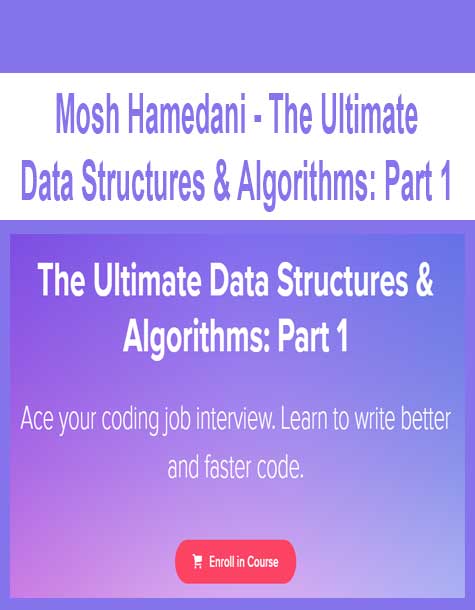Mosh Hamedani – The Ultimate Data Structures & Algorithms: Part 1
$10.00 Original price was: $10.00.$5.00Current price is: $5.00.
Proof of item:
Boost Your Employability
Studied Computer Science – but never really understood the complex topic of data structures and algorithms?
Or maybe you’re a self-taught programmer, with little to no knowledge of this important topic.
Or perhaps you failed a job interview because you couldn’t answer basic data structure and algorithm questions.
Data structures and algorithms are patterns for solving problems. Developers who know more about data structures and algorithms are better at solving problems.
That’s why companies like Google, Microsoft and Amazon, always include interview questions on data structures and algorithms. They want to assess your problem-solving skills. They don’t care how many programming languages and frameworks you’re familiar with
By the end of this course, you’ll be able to…
- Ace your next coding interview
- Write better, faster code
- Become a better developer
- Improve your problem solving skills
- Master computer science fundamentals
- Implement all the essential data structures from scratch
- Master dozens of popular algorithms
What You’ll Learn
This course is the first of a series. In this part, we’ll be focusing on linear data structures. Part 2 is all about trees and graphs. Part 3 is about searching, sorting and string manipulation algorithms.
Here’s what you’re going to learn in the first part:
- The Big O notation
- Arrays
- Linked Lists
- Stacks
- Queues
- Hash Tables
This is the most comprehensive data structures and algorithms series online. Every example and exercise is picked from popular interview questions asked by Google, Microsoft, Amazon and other big companies.
Who is this course for?
- Anyone preparing for a coding job interview
- Computer science students whose lecturers failed to explain the topics
- Self-taught developers who missed out on a computer science degree
- Anyone who wants to become a better developer
- Course CurriculumGetting Started
Preview1- Course Outline (2:52)
Start2- Source Code
The Big O Notation (16 m)
Preview1- Introduction (0:24)
Preview2- What is Big O (1:58)
Preview3- O(1) (1:29)
Preview4- O(n) (3:44)
Preview5- O(n^2) (2:24)
Start6- O(log n) (2:39)
Start7- O(2^n) (0:50)
Start8- Space Complexity (2:32)
Start9- Cheat Sheet
Arrays (30 m)
Start1- Introduction (0:44)
Start2- Understanding Arrays (3:08)
Start3- Working with Arrays in Java (3:29)
Start4- Exercise- Array Class (2:51)
Start5- Solution- Creating the Class (3:19)
Start6- Solution- insert() (4:19)
Start7- Solution- removeAt() (4:50)
Start8- Solution- indexOf() (2:28)
Start9- Dynamic Arrays (3:48)
Start10- Arrays- Exercises
Start11- Summary (1:09)
Linked Lists (54 m)
Start1- Introduction (0:36)
Start2- What are Linked Lists (4:33)
Start3- Working with Linked Lists (3:24)
Start4- Exercise- Building a Linked List (1:25)
Start5- Solution- addLast (6:09)
Start6- Solution- addFirst (2:13)
Start7- Solution- indexOf (1:54)
Start8- Solution- contains (1:05)
Start9- Solution- removeFirst (4:23)
Start10- Solution- removeLast (4:40)
Start11- Implementing size() (4:15)
Start12- Converting Linked Lists to Arrays (2:10)
Start13- Cheat Sheets (1:12)
Start14- Arrays vs Linked Lists (3:21)
Start15- Types of Linked Lists (3:14)
Start16- Exercise- Reversing a Linked List (1:33)
Start17- Solution- Reversing a Linked List (9:00)
Start18- Exercise- Kth Node from the End (3:20)
Start19- Solution- Kth Node from the End (5:22)
Start20- Linked Lists- Exercises
Start21- Summary (1:12)
StartA Quick Note
Stacks (42 m)
Start1- Introduction (0:31)
Start2- What are Stacks (2:47)
Start3- Working with Stacks (2:21)
Start4- Exercise- Reversing a String (0:41)
Start5- Solution – Reversing a String (5:01)
Start6- Exercise- Balanced Expressions (2:54)
Start7- Solution- A Basic Implementation (5:17)
Start8- Solution- Supporting Other Brackets (3:36)
Start9- Solution- First Refactoring (4:09)
Start10- Solution- Second Refactoring (5:50)
Start11- Exercise- Building a Stack Using an Array (0:47)
Start12- Solution- Implementing a Stack Using an Array (8:18)
Start13- Stacks- Exercises
Start14- Summary (0:33)
Queues (53 m)
Start1- Introduction (0:26)
Start2- What are Queues (2:04)
Start3- Queues in Java (5:12)
Start4- Exercise- Reversing a Queue (1:06)
Start5- Solution- Reversing a Queue (2:17)
Start6- Exercise- Building a Queue Using an Array (2:03)
Start7- Solution- A Basic Implementation (6:32)
Start8- Solution- Circular Arrays (5:54)
Start9- Exercise- Implementing a Queue Using a Stack (0:55)
Start10- Solution- Building a Queue Using a Stack (7:43)
Start11- Priority Queues (1:53)
Start12- Exercise- Building a Priority Queue (3:57)
Start13- Solution- Building a Priority Queue (8:51)
Start14- Solution- Refactoring (3:02)
Start15- Queues- Exercises
Start16- Summary (0:57)
Hash Tables (68 m)
Start1- Introduction (0:26)
Start2- What are Hash Tables (2:44)
Start3- Working with Hash Tables (6:06)
Start4- Exercise- Find the First Non-repeated Character (0:54)
Start5- Solution- First Non-repeating Character (7:39)
Start6- Sets (2:23)
Start7- Exercise- First Repeated Character (0:32)
Start8- Solution- First Repeated Character (2:36)
Start9- Hash Functions (5:55)
Start10- Collisions (1:06)
Start11- Chaining (1:40)
Start12- Open Addressing- Linear Probing (2:41)
Start13- Open Addressing- Quadratic Probing (1:29)
Start14- Open Addressing- Double Hashing (3:19)
Start15- Exercise- Build a HashTable (2:36)
Start16- Solution- put() (6:07)
Start17- Solution- get() (4:29)
Start18- Solution- remove() (2:30)
Start19- Solution- Refactoring (11:04)
Start20- Hash Tables- Exercises
Start21- Summary (1:25)
Start22- Course Wrap Up (0:32)
Start23- Thank You
1 review for Mosh Hamedani – The Ultimate Data Structures & Algorithms: Part 1
Sorry, no reviews match your current selections
Q & A
Ask a question
Your question will be answered by a store representative or other customers.
Thank you for the question!
Your question has been received and will be answered soon. Please do not submit the same question again.
Error
An error occurred when saving your question. Please report it to the website administrator. Additional information:
Add an answer
Thank you for the answer!
Your answer has been received and will be published soon. Please do not submit the same answer again.
Error
An error occurred when saving your answer. Please report it to the website administrator. Additional information:
Related products
Internet Marketing
Elena Mofar – CCNA 200-125 v3.0 (Cisco Certified Network Associate)
Internet Marketing
Internet Marketing
Internet Marketing
Internet Marketing
Internet Marketing
Internet Marketing
Nick Morton – Supplyant Consultancy Course – Foundation Level
Internet Marketing














Fast shipping, as described, Live Truth Live Catholic | Mosh Hamedani – The Ultimate Data Structures & Algorithms: Part 1